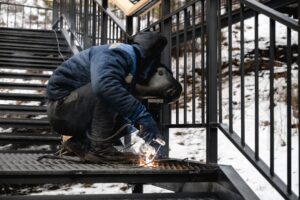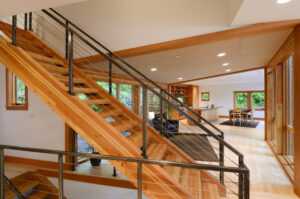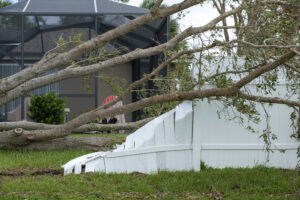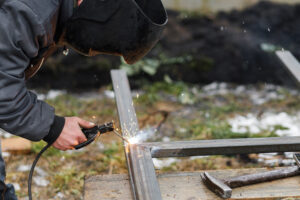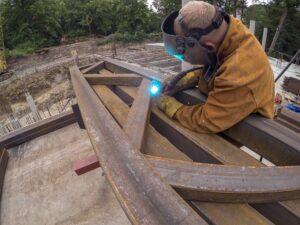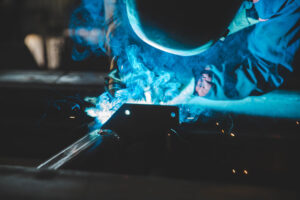Welding cast aluminum can be a challenging task, but with the right knowledge and techniques, it can be successfully accomplished. We will take you through the basics of cast aluminum, the importance of welding in cast aluminum, pre-welding preparations, different welding techniques, safety measures, and troubleshooting common welding issues.
Understanding the Basics of Cast Aluminum
Before diving into the welding process, it’s important to understand the properties of cast aluminum. Cast aluminum is a lightweight and versatile material known for its excellent corrosion resistance, high strength-to-weight ratio, and good thermal conductivity. It is commonly used in various industries such as automotive, aerospace, and construction.
The composition of cast aluminum consists mainly of aluminum, along with small amounts of other elements like silicon, magnesium, copper, and zinc. These alloying elements contribute to the unique properties of cast aluminum, making it an ideal choice for many applications.
Properties of Cast Aluminum
One of the key properties of cast aluminum is its strength. It has a high tensile strength, which allows it to withstand heavy loads and extreme conditions. This makes it suitable for applications where durability is crucial, such as in the construction of aircraft frames or automotive engine components.
Additionally, cast aluminum has excellent machinability, meaning it can be easily shaped and formed into complex shapes. This property makes it a preferred material for intricate designs and customized parts.
Another important property of cast aluminum is its corrosion resistance. It forms a protective oxide layer on the surface, which prevents further corrosion and extends the lifespan of the material. This makes cast aluminum suitable for outdoor applications where it is exposed to harsh environmental conditions, such as marine structures or outdoor furniture.
Importance of Welding in Cast Aluminum
Welding plays a crucial role in the fabrication and repair of cast aluminum components. It allows the joining of different pieces to create complex structures and repair damaged parts. However, welding cast aluminum comes with its own challenges due to its unique characteristics.
The high thermal conductivity of aluminum poses a challenge during the welding process. Heat dissipates quickly, making it necessary to use specialized techniques to maintain proper heat input and prevent distortion or warping of the material.
Another challenge is the potential for porosity and cracking. Cast aluminum contains impurities and gases that can be released during the welding process, leading to defects in the weld. Proper cleaning and preparation of the material, as well as the use of suitable filler metals and shielding gases, are essential to achieve sound welds.
Furthermore, controlling distortion and warping is crucial when welding cast aluminum. The material has a tendency to shrink and deform during the cooling process, which can affect the dimensional accuracy of the welded structure. Proper fixturing and heat management techniques are employed to minimize these effects and ensure the desired outcome.
By understanding these challenges and implementing proper techniques, successful welds can be achieved in cast aluminum. This allows for the creation of strong and reliable structures, as well as the repair and restoration of valuable components.
Pre-Welding Preparations
Before starting the welding process, it is essential to prepare the cast aluminum surface properly.
Welding cast aluminum requires careful attention to detail and thorough preparation to ensure a strong and durable weld. In this section, we will delve deeper into the pre-welding preparations, exploring the steps involved and the importance of each.
Cleaning the Aluminum Surface
The first step in preparing the cast aluminum surface is to clean it thoroughly. This is crucial as any dirt, grease, or oxides present on the surface can hinder the welding process and compromise the quality of the weld.
There are several methods to clean the aluminum surface effectively. One commonly used method is to use a wire brush to remove any loose dirt or debris. This helps to create a clean surface for the welding process.
In addition to using a wire brush, degreasing solvents or chemical cleaners specifically designed for aluminum can be used to remove any grease or oil residues. These solvents help to dissolve and remove the contaminants, ensuring a clean welding surface.
Furthermore, it is crucial to remove any existing paint or coatings from the surface before welding. Paint or coatings can negatively impact the weld quality, leading to weak joints or even weld failure. To remove these coatings, it is recommended to use a grinder or sandpaper. This process not only removes the coatings but also helps create a clean and smooth welding surface.
Choosing the Right Welding Equipment
Selecting the appropriate welding equipment is vital for successful cast aluminum welding. Different welding techniques can be used, depending on the specific requirements of the project.
Two common welding techniques used for cast aluminum are Gas Tungsten Arc Welding (GTAW) and Gas Metal Arc Welding (GMAW).
Gas Tungsten Arc Welding (GTAW), also known as TIG welding, is a precise and versatile welding process. It uses a non-consumable tungsten electrode to create the weld. GTAW is often preferred for cast aluminum welding as it provides excellent control over the heat input and allows for precise weld bead placement.
On the other hand, Gas Metal Arc Welding (GMAW), also known as MIG welding, uses a consumable electrode and a shielding gas to protect the weld from atmospheric contamination. GMAW is known for its high productivity and ease of use, making it a popular choice for welding aluminum.
When choosing the welding equipment, factors such as the thickness of the cast aluminum, the desired weld quality, and the available resources should be taken into consideration. It is essential to consult with welding professionals or experts to determine the most suitable welding technique and equipment for the specific project.
Different Welding Techniques for Cast Aluminum
When it comes to welding cast aluminum, there are several techniques that can be employed to achieve strong and reliable welds. Two commonly used techniques are Gas Tungsten Arc Welding (GTAW) and Gas Metal Arc Welding (GMAW).
Gas Tungsten Arc Welding (GTAW)
Gas Tungsten Arc Welding, also known as TIG welding, is a widely used technique for welding cast aluminum. It employs a non-consumable tungsten electrode and an inert shielding gas to protect the weld pool from atmospheric contamination.
One of the key advantages of GTAW is its ability to provide precise control over the welding process. This allows for clean and aesthetically pleasing welds, making it a popular choice for applications where appearance is important. Additionally, GTAW is well-suited for welding thin sections and intricate designs, as it allows for a high level of accuracy and detail.
Another benefit of GTAW is its versatility. It can be used to weld a wide range of aluminum alloys, making it a valuable technique for various industries, including automotive, aerospace, and marine.
Gas Metal Arc Welding (GMAW)
Gas Metal Arc Welding, commonly known as MIG welding, is another popular technique for welding cast aluminum. It uses a consumable wire electrode and a shielding gas to protect the weld pool.
GMAW offers high productivity and is suitable for welding thicker sections and larger welds. This makes it a preferred choice for industrial applications where speed and efficiency are key. The use of a consumable wire electrode also allows for continuous welding, reducing the need for frequent stops and starts.
Like GTAW, GMAW is widely used in various industries, including automotive, construction, and manufacturing. It is particularly well-suited for applications that require high strength and durability.
Both GTAW and GMAW have their own advantages and are suitable for different welding scenarios. The choice of technique depends on factors such as the thickness of the aluminum, the desired appearance of the weld, and the specific requirements of the application.
It is worth noting that welding cast aluminum can present some challenges, as the material has a tendency to crack and distort during the welding process. Proper preparation, including preheating and the use of appropriate filler materials, is crucial to achieving successful welds and minimizing the risk of defects.
Overall, with the right technique and proper execution, welding cast aluminum can result in strong and reliable welds that meet the demands of various industries.
Safety Measures During Welding
Welding cast aluminum requires utmost attention to safety. To ensure your well-being, it is essential to prioritize personal protective equipment (PPE) and create a safe welding environment.
Personal Protective Equipment (PPE)
When working with cast aluminum, it is crucial to equip yourself with the appropriate PPE. Safety glasses are essential to shield your eyes from potential hazards such as ultraviolet radiation, sparks, and flying debris. Welding helmets with appropriate shade levels provide additional protection for your face and neck.
Furthermore, welding gloves are a necessity to safeguard your hands from burns and cuts. These gloves are specifically designed to withstand the high temperatures and spatters associated with welding. Additionally, flame-resistant clothing is vital to protect your body from potential burns and injuries caused by sparks or molten metal.
Remember, compromising on safety when welding cast aluminum or any other material is never an option. Your well-being should always be the top priority.
Safe Welding Environment
Creating a safe welding environment is equally important to ensure a secure working environment. Proper ventilation is crucial to remove harmful fumes and gases generated during the welding process. If you are working indoors, it is essential to use exhaust fans or other ventilation systems to maintain clean air quality.
In addition to ventilation, it is vital to keep the area around the welding station clear of flammable materials. This precaution minimizes the risk of accidental fires. Establishing a fire-safe work zone is essential to prevent any potential hazards.
As an additional safety measure, it is imperative to have fire extinguishers readily available in case of emergencies. Familiarize yourself with the proper use of fire extinguishers to ensure you can respond effectively to any fire-related incidents.
By adhering to these safety measures, you can mitigate potential risks and ensure a safe welding experience when working with cast aluminum or any other material.
Troubleshooting Common Welding Issues
Welding is a complex process that requires careful attention to detail and a thorough understanding of the materials being joined. When it comes to cast aluminum welding, there are several common issues that welders often encounter.
Cracking and Porosity
Cracking and porosity are two of the most common problems faced during cast aluminum welding. Cracks can occur due to a variety of factors, including improper heat treatment and high levels of residual stress. To reduce the risk of cracks, it is essential to create a proper preheat and post-weld heat treatment plan.
Preheating the casting helps reduce thermal stress, allowing for a smoother welding process. By gradually increasing the temperature of the casting before welding, you can minimize the likelihood of cracks forming. Additionally, post-weld heat treatment is crucial for relieving residual stresses that could lead to cracking. This process involves heating the welded area to a specific temperature and then slowly cooling it down, ensuring that the material remains stable and free from cracks.
Porosity, on the other hand, refers to the presence of gas pockets in the weld. These gas pockets can weaken the weld and compromise its integrity. To minimize porosity, it is important to follow proper welding techniques and ensure the cleanliness of the base metal.
Adequate shielding gas coverage is essential for preventing porosity. The shielding gas creates a protective atmosphere around the weld, preventing the formation of gas pockets. Additionally, using a filler wire that is compatible with cast aluminum can help mitigate porosity. The filler wire should have similar chemical composition and mechanical properties to the base metal, ensuring a strong and reliable weld.
Distortion and Warping
Distortion and warping are common issues that occur during the cooling process after welding. When the weld cools down, it contracts, causing the material to deform. This deformation can lead to distortion and warping, affecting the overall quality of the weld.
To minimize distortion, it is important to use proper clamping and fixturing techniques. Clamping the material securely in place during welding can help control its movement and prevent excessive deformation. Additionally, using fixtures that support the material and distribute the heat evenly can also help minimize distortion.
Equalizing the heat distribution is another effective way to reduce distortion and warping. By alternating between welding on different sides of the joint, you allow for even cooling and minimize the risk of deformation. Welding in small sections rather than long continuous runs can also help reduce distortion, as it allows for better control over the heat input and cooling process.
Troubleshooting common welding issues in cast aluminum requires a combination of knowledge, skill, and attention to detail. By understanding the basics of cast aluminum, taking the necessary pre-welding preparations, choosing the right welding techniques, implementing safety measures, and troubleshooting effectively, you can achieve strong and reliable welds in cast aluminum. Remember, patience and practice are key to mastering the art of welding.

